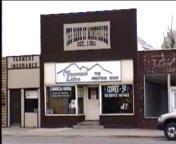Butch Cassidy at Montpelier

On August 13, 1896 Butch Cassidy robbed the Montpelier bank of gold, silver, and currency worth between $5,000-$15,000. Montpelier, Idaho, had the number one chartered bank in the state at the time. Cassidy rode into town with two accomplices, Elza Ray and Bob Meeks. His party stopped at the saloon for drinks. Afterwards, they headed over to the bank and carried out the robbery. Cassidy and Ray forced the teller, A. N. Mackintosh, to gather all the cash. They then put him up against the wall along with the other customers in the bank. While the robbers proceeded to collect anything of value. Once everything was gathered, Cassidy told his captors to wait ten minutes before they went outside. Mackintosh immediately reported the robbery to the sheriff who managed the local general store as well. The sheriff, however, did not own a horse so he attempted to give chase on a bicycle. As a result, Cassidy and his posse easily escaped on horseback.
Cassidy may have chosen to rob Montpelier bank because he needed money to pay the court and attorney fees for a former gang member Matt Warner, who was convicted of killing a couple of men in a gunfight. Cassidy also had apparently promised a judge in Wyoming that he wouldn’t commit any crimes within that state. Regardless of the true reasoning behind the robbery the Montpelier bank has been remodeled into a museum to where people can go to see where the famous robbery occurred.
Images

